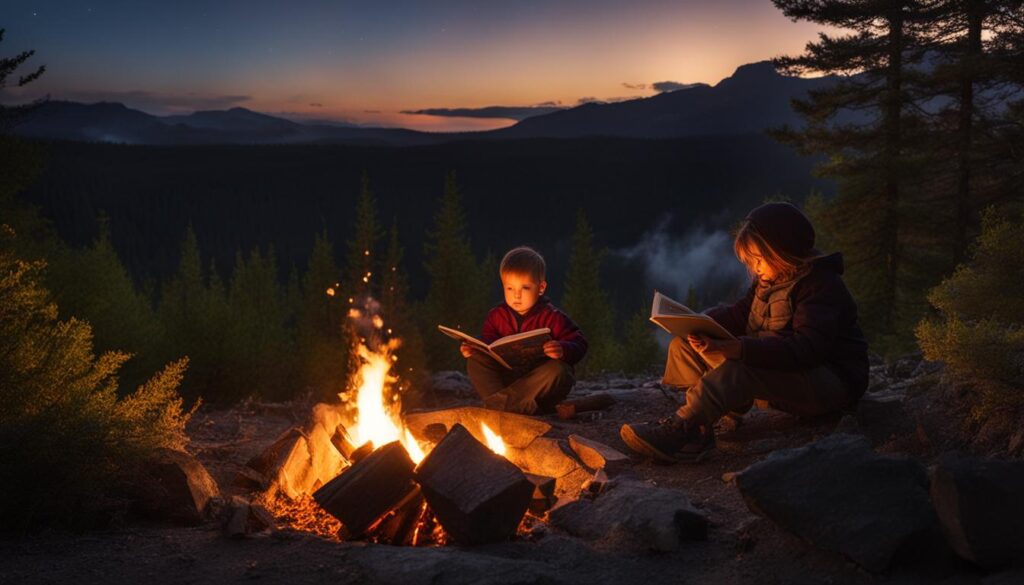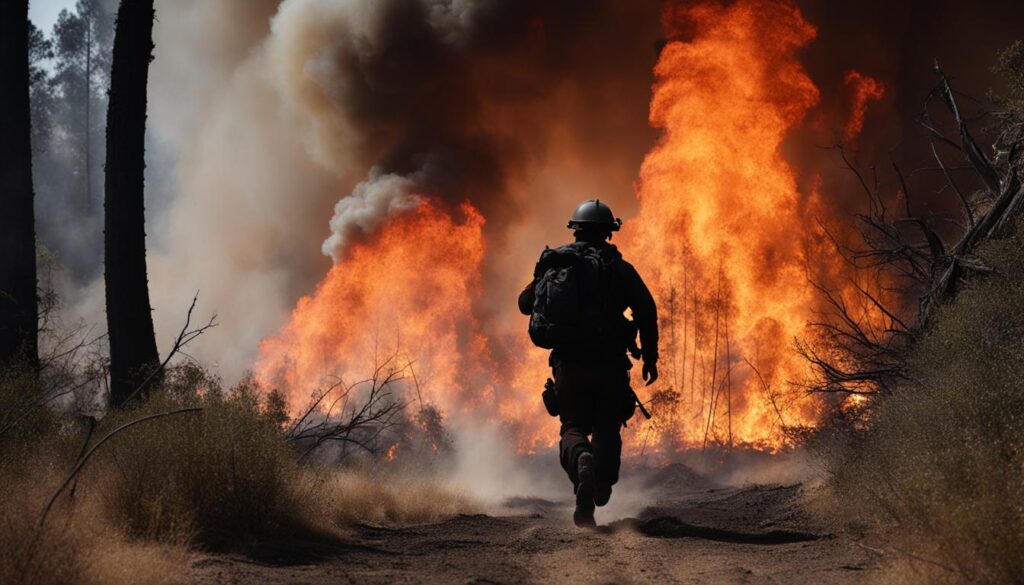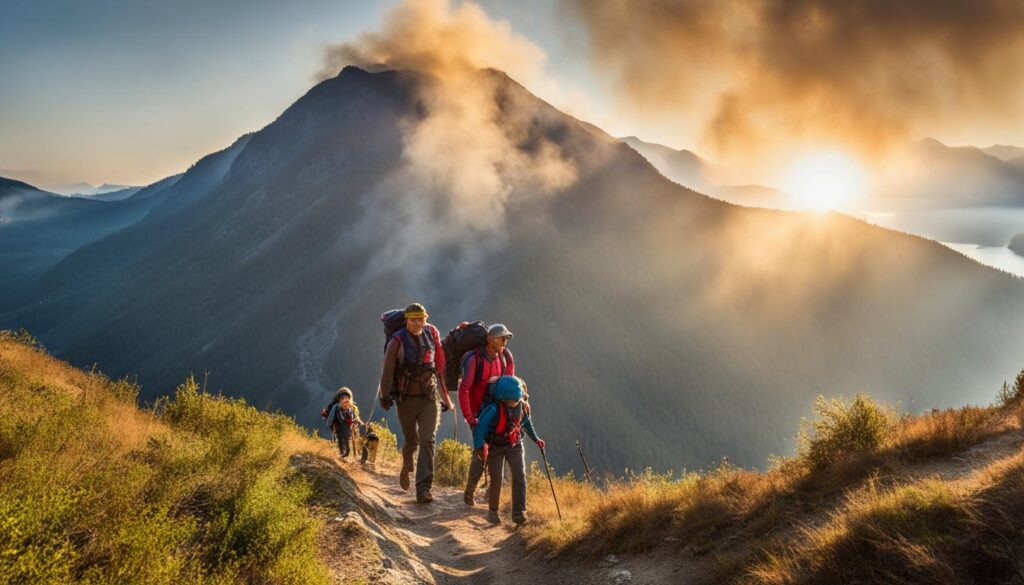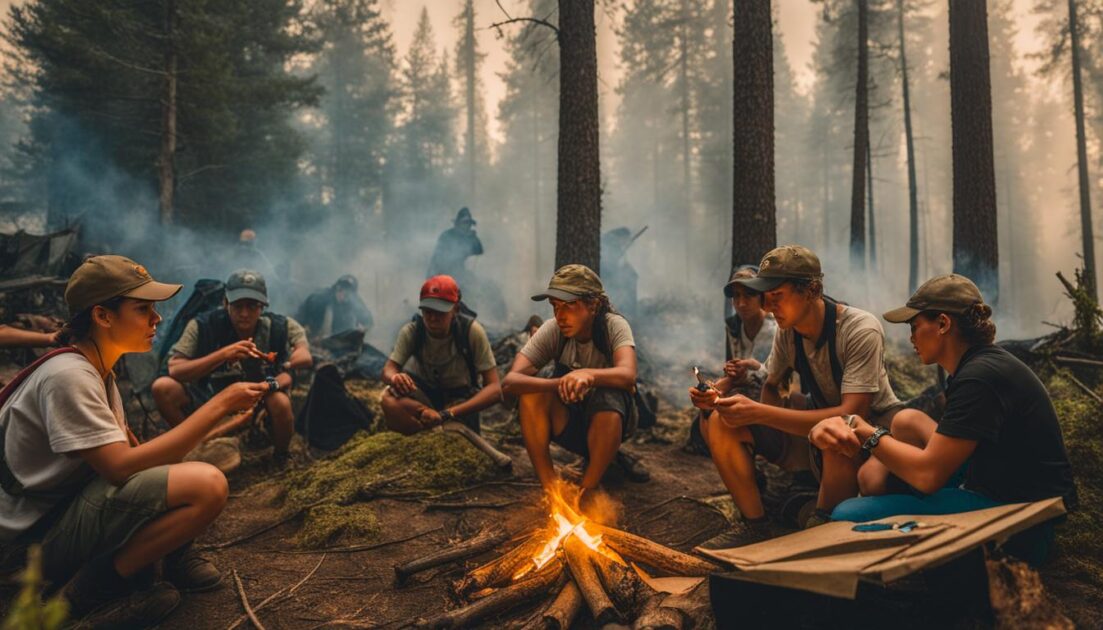As an avid camper and nature enthusiast, I have always enjoyed the serenity and adventure of spending time in the great outdoors. However, there was one camping trip that turned into a harrowing experience I will never forget. While exploring a picturesque forested area, a sudden forest fire ignited, threatening my safety and the survival of those around me.
In this article, I will share my personal survival tale and provide invaluable tips on how to navigate and endure a forest fire while camping. From assessing the risks and planning ahead to deciding between escape and taking shelter, I will guide you through the essential steps to increase your chances of survival in such a dire situation.
Before we delve into the specifics, let me offer a few key takeaways:
Key Takeaways:
- Assess the risks and gather information about the area from local park rangers or authorities
- Develop a well-thought-out escape plan, considering fire severity, location, proximity to escape routes, weather, and terrain
- When faced with an immediate threat, prioritize moving upwind and downhill
- Look for natural firebreaks and avoid open areas or dry scrub brush
- If escape is not possible, take shelter in a trench or deep gulley, covering yourself with a tarp or blanket or burying yourself with dirt
Now, let’s dive into each section in detail to ensure you’re equipped with the knowledge and strategies necessary to survive a forest fire while camping.
Assessing the Risks and Planning Ahead
When venturing into the wilderness, it is crucial to assess the risks and plan ahead for potential dangers, particularly when it comes to forest fires. By understanding the factors that contribute to the severity and spread of wildfires, you can develop effective survival strategies. Here are some key considerations:
Gather Information and Seek Expert Advice
Before embarking on your camping adventure, consult with local park rangers or forest authorities to obtain vital information about the area’s fire risk. They can provide insights into recent fire incidents, weather conditions, fire restrictions, and evacuation routes.
Identify Fire Severity and Location
Assessing the severity of a forest fire is crucial as it determines the appropriate response. Is the fire spreading rapidly or more contained? Identify the fire’s location in relation to your camping site and escape routes.
Evaluate Proximity to Escape Routes
Take note of the nearest evacuation routes and how far your campsite is from these exit points. In case of a rapid fire spread, you need to be aware of the time it takes to reach safety.
Consider Weather and Terrain
Weather conditions play a significant role in fire behavior. High winds can escalate the spread, so it’s important to assess wind patterns and anticipate potential changes. Additionally, examining the terrain, such as steep slopes or narrow valleys, can help determine routes that are safer and less prone to fire activity.
| Factors to Consider | |
|---|---|
| Fire Severity | Is the fire spreading rapidly or contained? |
| Location | Relative to your campsite and escape routes |
| Escape Routes | Distance and accessibility |
| Weather | Wind patterns, potential changes |
| Terrain | Steep slopes, narrow valleys |
By carefully assessing these risks and planning ahead, you can make informed decisions during an emergency situation. In the face of a forest fire, knowing your escape routes, understanding fire behavior, and being prepared for various scenarios can greatly increase your chances of survival.
Escape or Take Shelter
When facing a forest fire, time is crucial, and outrunning the flames is often not possible. Forest fires can spread at incredible speeds, making it dangerous to attempt to flee on foot. The risk of encountering new flare-ups ignited by embers further complicates the situation. In such cases, it is best to prioritize your safety and take shelter.
Escaping a forest fire:
If you find yourself in a situation where escape is feasible, you should move upwind and downhill, following designated escape routes if available. It is essential to avoid open areas and dry scrub brush, as they can fuel the fire’s intensity. Look for natural firebreaks such as roads or areas without combustible material and make every effort to reach them. Stay low to reduce smoke inhalation and cover your mouth and nose with a wet cloth if possible.
Taking shelter:
If escape is not an option, taking shelter is your best course of action. One method is to find a trench or a deep gulley where you can seek refuge. Dig a hole and cover it with a tarp or a blanket, creating a protective barrier against heat and flames. Another approach involves lying down in a trench with your feet facing the direction of the flames, covering yourself with dirt to shield from radiant heat.
Remember to leave yourself space to breathe while ensuring your body remains as covered as possible. Stay calm and wait for the fire to pass over you.
“In a forest fire situation, it is crucial to prioritize safety and make informed decisions. If escape is not feasible, taking shelter can significantly increase your chances of survival.”
To better understand the concept of escape and take shelter, refer to the table below:
| Escape | Take Shelter |
|---|---|
| Moving upwind and downhill | Finding a trench or deep gulley |
| Utilizing designated escape routes | Digging a hole and covering it with tarp/blanket |
| Avoiding open areas and dry scrub brush | Lying down in a trench with feet facing flames |
| Reducing smoke inhalation | Covering yourself with dirt |
By assessing your situation and making informed decisions, you can increase your chances of surviving a forest fire. Remember, each scenario is unique, so adapt the strategies mentioned above to the specific conditions you are facing.
Safe Campfire Tips
When enjoying the great outdoors, it is essential to prioritize campfire safety to prevent wildfires. By following these safe campfire practices, you can minimize the risk of fires spreading uncontrollably and ensure a safe outdoor experience.
1. Check for Burn Bans and Use Designated Fire Rings or Fire Pits
Before sparking a fire, check local regulations and any burn bans in effect. Many areas have designated fire rings or fire pits where campfires are permitted. Using these designated areas helps contain the fire and prevent it from spreading to the surrounding vegetation.
2. Keep Your Campfire Small and Under Control
It’s crucial to maintain a manageable campfire size. Avoid building a fire that is too large, as it increases the risk of embers and sparks flying out of control. Keep the flames contained within the fire ring or pit and add only enough wood to maintain a small, controlled fire.
3. Never Leave Your Campfire Unattended
One of the most important campfire safety tips is to never leave your fire unattended. Even a small spark or ember can quickly ignite nearby dry grass or leaves, leading to a forest fire. Always ensure there is a responsible adult keeping an eye on the fire at all times.
4. Ensure Your Campfire Burns Completely to Ash Before Extinguishing
Before leaving your campsite or going to bed, make sure your campfire is completely extinguished. Allow the firewood to burn down to ash, then carefully pour water over the ashes, ensuring they are cool to the touch. Gently stir the ashes to make sure no hidden embers are still burning.
5. Follow Leave No Trace Guidelines
Following Leave No Trace principles not only helps preserve the natural beauty of our outdoor spaces but also contributes to campfire safety. Properly dispose of any trash or debris, avoid using accelerants to start the fire, and minimize the impact on the environment.
Remember, preventing wildfires is everyone’s responsibility. By practicing safe campfire techniques and being proactive in fire prevention, we can enjoy the beauty of nature while minimizing the risk of devastating wildfires.

A Chaplain’s Miraculous Escape
In the midst of the devastating Camp Fire that swept through California, a chaplain by the name of Brad Brown found himself facing a harrowing situation. Trapped in his Honda Odyssey with sick and scared passengers, they were surrounded by flames, their lives hanging in the balance. In the face of such overwhelming danger, Brown turned to his faith, invoking prayers for protection and guidance.
“In times of crisis, our belief and hope become the pillars of strength,” Brown reflects. “We find solace in the power of something greater than ourselves.”
As the fire raged around them, Brown and his companions clung to the hope that a miraculous escape was possible. They held firm, weathering the inferno with courage and determination. And miraculously, against all odds, they emerged from the devastation unscathed.
“The flames were relentless, but our spirits remained unyielding,” Brown shares. “It is a testament to the strength of faith and the triumph of the human spirit in the face of dire circumstances.”
Brown’s remarkable story serves as a powerful reminder of the resilience and the power of hope even in the midst of the most challenging circumstances. It showcases the unwavering strength of the human spirit and the extraordinary lengths we are capable of reaching when faced with the unimaginable.
Through his ordeal, Brad Brown’s story inspires us all to have faith in the face of adversity and to cling to hope in times of despair.

| Keyword | Count |
|---|---|
| chaplain | 1 |
| miraculous escape | 2 |
| forest fire | 1 |
A Family’s Journey to Safety
Brad Brown’s family, including his teenage son Jaron and his grandmother, experienced the terrifying Camp Fire firsthand. As the flames closed in, they relied on Jaron’s quick thinking and bravery to ensure their survival.
During the chaotic evacuation, Jaron took charge and led the family to safety in their truck. His determination and levelheadedness played a critical role in navigating through the chaos and finding a route to escape.
For the Brown family, the journey to safety was particularly challenging. They had already endured the painful loss of their mother to cancer, and now they were faced with the destructive force of the Camp Fire. Despite these unimaginable hardships, they found the strength to persevere and protect one another.
Their remarkable story is a testament to the power of resilience and unity in the face of adversity. It serves as an inspiration for families navigating through difficult times, reminding us that even in the darkest moments, there is hope and the possibility of survival.

| Family Members | Role |
|---|---|
| Brad Brown | Father |
| Jaron Brown | Teeange Son |
| Grandmother | Family Matriarch |
The Importance of Fire in Survival
Fire is an essential element for survival in various scenarios, including camping and emergency situations. Its significance cannot be underestimated, as it provides numerous benefits and plays a vital role in ensuring our well-being.
When it comes to survival, fire serves multiple purposes. Here are some key reasons why fire is crucial:
- Warmth: Fire provides heat, which is essential for maintaining body temperature and preventing hypothermia, especially in cold environments.
- Water Purification: Fire can be used to purify water by boiling it, killing harmful bacteria, parasites, and other microorganisms that can cause illness.
- Insect Deterrent: The smoke generated by fire helps repel insects, such as mosquitoes and flies, providing a more comfortable outdoor experience.
- Signaling: Fire can be used as a form of visual signaling in emergency situations, helping search and rescue teams locate individuals who need assistance.
Starting and maintaining a fire requires understanding the three components of fire: oxygen, fuel, and ignition. Proper preparation is crucial, including gathering sufficient tinder, kindling, and fuel wood. There are various methods to start a fire, such as using matches, lighters, fire starters, or primitive techniques like friction-based methods.
To ensure fire safety, it is important to follow precautions:
- Choose a safe location for your fire, away from flammable materials and in a designated fire ring or pit if available.
- Clear the area around the fire, removing dry leaves, branches, and other combustible materials.
- Keep a bucket of water or a fire extinguisher nearby to extinguish the fire if needed.
- Never leave a fire unattended and ensure it is completely extinguished before leaving the area.
By understanding the importance of fire and practicing fire safety, we can enjoy its benefits while minimizing the risk of wildfires or accidents.
Preventing Wildfires and Fire Safety
Wildfires are a devastating force that can wreak havoc on nature, communities, and lives. Many of these fires are unfortunately caused by human activities such as unattended campfires, fireworks, and discarded cigarettes. As responsible individuals, it is crucial that we prioritize fire safety and take proactive measures to prevent wildfires.
One of the most effective ways to prevent wildfires is to be mindful of fire safety regulations and restrictions, especially during dry conditions. Always check for burn bans and follow any guidelines set by local authorities. When enjoying a campfire, it is essential to properly extinguish it before leaving the area. Use water to douse the fire, ensuring that there are no embers or smoldering materials left behind.
Careless smoking also poses a significant risk of starting wildfires. Avoid discarding cigarette butts on the ground or in vegetation. Make sure to dispose of them properly in designated containers. Additionally, it is essential to be aware of fire-resistant materials when in fire-prone areas. Consider using fire-resistant fabrics and building materials, which can greatly reduce the spread of flames in case of an accidental fire.
Negligence in fire safety can have severe consequences, not only in terms of property damage but also for the safety of lives. Individuals who fail to follow fire safety guidelines may be held liable for the damages caused by their actions. By taking the necessary precautions and being responsible stewards of nature, we can all contribute to preventing wildfires and creating a safer environment for everyone.
FAQ
What should I do before camping in an area prone to forest fires?
It is crucial to assess the risks in the area and gather information from local park rangers. Understanding the fire severity, location, proximity to escape routes, weather, and terrain can help you plan accordingly.
Can I outrun a forest fire while camping?
Running away from a forest fire is often not possible, as flames can spread rapidly. It is best to move upwind and downhill when attempting to escape. Look for natural firebreaks, such as roads or areas without combustible materials, while avoiding open areas and dry scrub brush.
What should I do if I cannot escape a forest fire while camping?
If escape is not feasible, take shelter in a trench or a deep gulley. Dig a hole and cover it with a tarp or blanket, or lie down in a trench with your feet facing the flames and cover yourself with dirt. Ensure you can breathe and wait for the fire to pass over you.
How can I prevent wildfires while camping?
Follow safe campfire practices, such as using designated fire rings or pits, keeping the campfire small and under control, never leaving it unattended, and ensuring it burns completely to ash before extinguishing it with water. Additionally, follow Leave No Trace guidelines and visit smokeybear.com for more campfire safety tips.
Can you share a survival tale of someone trapped in a forest fire while camping?
Yes, during the Camp Fire in California, a chaplain named Brad Brown and his family found themselves trapped in the flames. Despite the danger, they managed to survive, showcasing the power of hope and belief in the face of danger.
Tell me a story of a family’s journey to safety during a forest fire while camping.
Brad Brown’s family, including his teenage son Jaron and his grandmother, also faced the Camp Fire. Through quick thinking and bravery, Jaron played a crucial role in evacuating the family in their truck. Their story represents resilience and strength in the face of adversity.
Why is fire important in survival situations while camping?
Fire provides warmth, helps purify water, keeps insects away, and can aid in search and rescue efforts. Understanding fire components and having proper tinder, kindling, and fuel wood are essential for starting and maintaining a fire while camping.
How can I prevent wildfires and ensure fire safety while camping?
Prevent wildfires by properly extinguishing campfires, avoiding careless smoking, and using fire-resistant materials. It is important to follow regulations and restrictions during dry conditions. Remember, negligence in fire safety can have severe consequences, and individuals may be held liable for damages caused by their actions.

